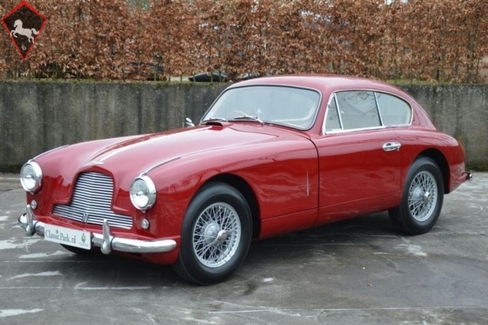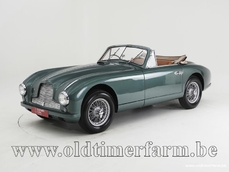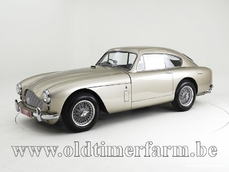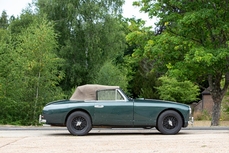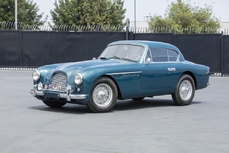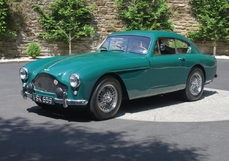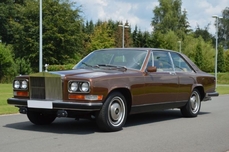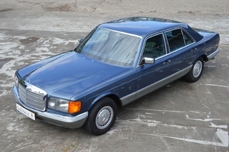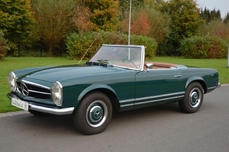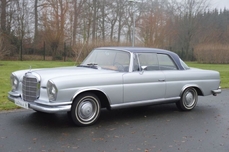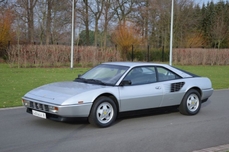Aston Martin DB2 /4 MKI Coupé 1954
General description :
Im April 1953 verließen die ersten Aston Martin DB2/4 MK1 das Werk. Die Konstruktion des von1953-1955 angebotenen Modells beruhte auf dem DB2, den er ersetzte. Allerdings war er als 2+2 Sitzer ausgelegt und hatte somit zusätzlich zwei Notsitze im Fond. Der „Erste Hatchback der Weld“, mit einer neuartigen Heckklappe. Weitere Änderungen waren „One Piece“ Windschutzscheibe und versetzte Scheinwerfer. Der 2580 ccm Motor mit seinen zwei obenliegenden Nockenwellen leistete 106 PS bei 5000 Touren, wie beim DB2 (W.O. Bentleys Lagonda 6 Zylinder). Im Jahr 1955 gewannen drei Werksautos einen Preis in der Mille Miglia und der Monte Carlo Rallye. Spezifik Der angebotene Aston Martin ist neu ausgeliefert in 1954 als Rechtslenker mit Fahrgestell Nummer LML 604. Das Auto wir geliefert mit der Originale Auslieferungsschein und Factory Garantie-Arbeiten. Der Außen Lackierung wird Imperial Crimson Red genannt mit Innen Beige Ledersitze, Beige Teppiche und ein Beige Himmel. Alles heute wie bei Auslieferung 1954. Das Auto hat ein total Body-off Restauration in England bekommen, welche mehrere Jahre gedauert hat, mit Fertigstellung in 2000. Inklusive war die Revidierung der original Motor, original Getriebe (nummern sind in 2017 mit ein Kamera Kontrolliert) und Radaufhängung/Federung. Seit dem nur mäßig gefahren. 3 Große Ordner mit Fotos, Belege und Historie belegen die Restauration und Historie von dem Fahrzeug gehören zum Auto. Wie man am jetzigen Zustand von Lack, Spaltmaße, Chrom, Glas, Period Leder und Teppiche sehen kann, ist eine sehr genaue und penible Restauration durchgeführt worden. Das Holz-Armaturenbrett wurde geschliffen, mit Bootslack behandelt und mit den original, überholten Instrumenten versehen. Diese Auto hat nur vier Besitzer gehabt, die ersten drei aus der Grafschaft Devon in England. Der letzte Besitzer aus Nord England hatte den Aston 50 Jahre lang. Diese Aston ist eine Freude zu fahren in allen Aspekten. Ein Glanzstück der Automobilgeschichte und dadurch natürlich auch ein gute Investition. Diese Auto ist Mille Miglia erlaubt und kommt mit ein Englische Zulassung auf das original Nummer.
1954 Aston Martin DB2 /4 MKI Coupé is listed for sale on ClassicDigest in Koppenhoefstraat 14NL-5283 VK Boxtel by Classic Park for €249900.
Car Facts
Car type : Car Make : Aston Martin Model : DB2 Model Version : /4 MKI Coupé Engine size : 2.6 Model Year : 1954 Sub type : Coupé Location : Koppenhoefstraat 14NL-5283 VK Boxtel Vehicle Registration : Undefined
249900 €
People who viewed this Aston Martin DB2 also viewed similar Aston Martin listed at ClassicDigest
Other cars listed for sale by this dealer
About Aston Martin DB2
The Aston Martin DB2 is a significant model in Aston Martin's history and played a crucial role in establishing the brand as a leading manufacturer of luxury sports cars. Here's an overview of its history, specifications, production numbers, and competition history:1. History: The Aston Martin DB2 was introduced in 1950 as the successor to the Aston Martin 2-Litre Sports. It was the first Aston Martin to be powered by the company's in-house designed engine. The DB2 featured a sleek and aerodynamic body designed by Frank Feeley.
2. Specifications:
- Engine: The DB2 initially featured a 2.6-liter inline-six engine, known as the "W.O. Bentley" engine. Later versions, including the DB2/4 and DB2/4 MkII, were equipped with a larger 2.9-liter engine.
- Power: The power output varied across different versions, but it generally ranged from approximately 105 to 140 horsepower.
- Transmission: The DB2 was offered with a 4-speed manual transmission, and some later models featured an optional 3-speed automatic transmission.
3. Production Numbers: Aston Martin produced the DB2 in various iterations from 1950 to 1953. The exact production numbers for each variant are as follows:
- Aston Martin DB2: Approximately 411 units produced.
- Aston Martin DB2/4: Approximately 565 units produced.
- Aston Martin DB2/4 MkII: Approximately 199 units produced.
4. Competition History: The Aston Martin DB2 achieved notable success in motorsport, contributing to Aston Martin's reputation for producing competitive sports cars. Some significant competition highlights include:
- 1950 24 Hours of Le Mans: Aston Martin DB2 finished 1st and 2nd in the 3.0-liter class, marking Aston Martin's first overall victory at Le Mans.
- 1951 Spa 24 Hours: DB2 won the race in the 3.0-liter class.
- 1952 Monte Carlo Rally: Aston Martin DB2 achieved a class victory.
- 1953 Mille Miglia: Aston Martin DB2 finished 1st and 2nd in the 3.0-liter class.
The success of the DB2 and its racing achievements laid the foundation for subsequent Aston Martin models and solidified the brand's reputation for producing high-performance sports cars.
Overall, the Aston Martin DB2 is an important model in Aston Martin's history, representing the transition to in-house engine production and establishing the brand's presence in the luxury sports car market. Its combination of elegant design, performance, and motorsport success contribute to its desirability among collectors and automotive enthusiasts today.
